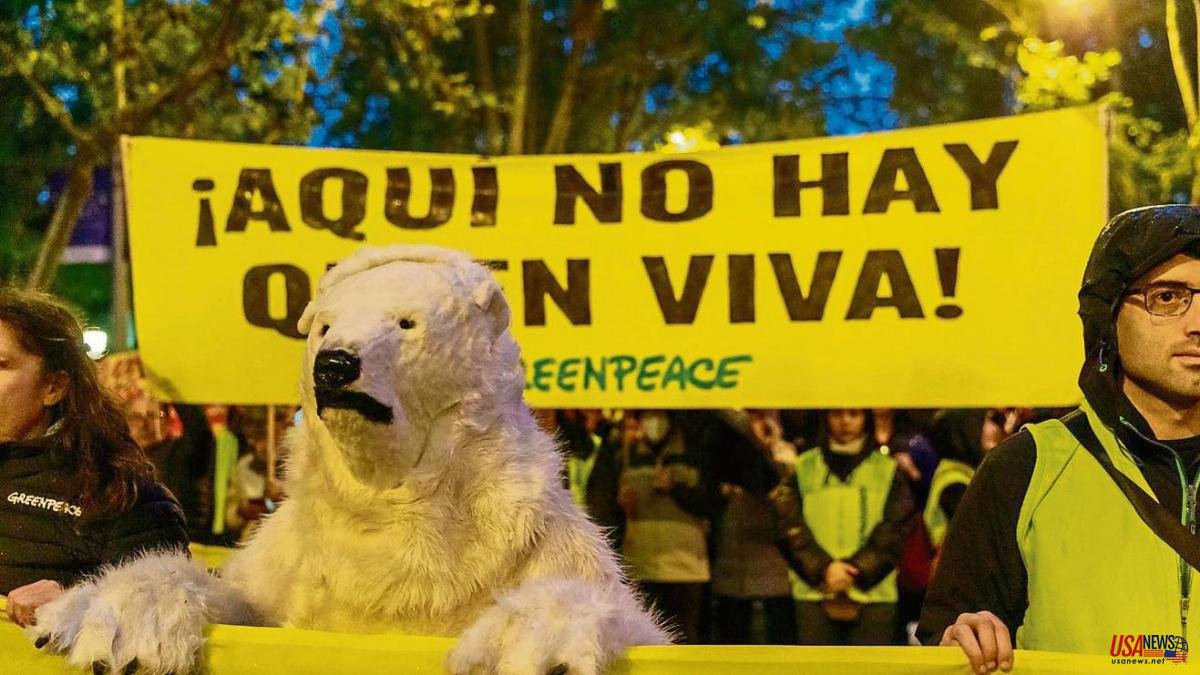Against the Circular Economy
“But what is garbage, what is garbage, then? It is not a rhetorical question. Quite the contrary, it must be answered many times a day, many millions of people around the globe ask it daily: are the twenty volumes of that encyclopedia bought twenty years ago rubbish? And the box full of cables? And the green of the leeks? And the folders of drawings of the boy, who was a genius? And the old shoes, and the old clothes? Oscar Calavia
Sustainability does not travel alone. In recent years, as we have seen, she has surrounded herself with a battalion of terms that surround and protect her, nourishing her aura as umbrellas for the future. The most popular among them is undoubtedly “circular economy”.
If we do the search in Google, we will see a panoply of perfect circles, conveniently segmented. In them the scheme is repeated: product design, production, distribution, consumption, collection, recycling and starting over. On paper —or the screen— it is perfect: waste becomes resources, with which we will need to extract much less material and we will avoid waste. The circular economy thus stands as the strongest defense of sustainability, the millimeter gear through which we will achieve the eternal youth of materials and, what is even more important, of the capitalist consumer society.
However, the circular economy is a pipe dream at the level of the alchemists' philosopher's stone. It is, plain and simple, pseudoscience. Labeling any advance in efficiency as a circular economy —a fact that is often repeated in the economic supplements of newspapers or in the sponsored content of Sunday newspapers— what is achieved is to trivialize the term and delegitimize the present action. The economy is inherently non-circular, since it will always need inputs of some kind: energy, materials, labor power. Being benevolent with the definition, we can get close to a spiral economy, in which we will need a constant flow of inputs, even if we are able to recirculate some of them. But we will never come full circle.
The economist Joan Martínez Alier has been warning of this impossibility for some time, in his books and conferences. He expresses it in these terms in an interview1 with the journalist Laura Villadiego:
“This circular economy fad is ridiculous. We know that, if each year, in round numbers, about ten tons per person (fossil fuels, biomass, construction materials, metals) enter the economy, only one ton of these materials is recycled, all the rest is "fresh" material. that comes from the frontiers of extraction. It is what is called the Circularity Gap, the gap in circularity. The industrial economy is entropic, it is not circular. It is increasingly entropic. [...] Energy is not recycled. The materials are recycled only in a small part. Many of them go to urban infrastructures, to buildings and stay there for a few decades, and then to waste. Maintaining buildings and transportation systems wastes energy and materials. The industrial economy is not circular, it is entropic”.
Alier is right: it is a fashion, but it has not arisen out of nowhere. It has been conveniently manufactured and disseminated. Although it now seems to us a common term in news and talks about the environment, it did not become popular until a few years ago, after the presentation of the Circular Economy Action Plan of the European Union, in 2015. This was the result of lobbying efforts of a group of companies that made up the “Circular Economy 100” network, established in 2013 and led by the Ellen McArthur Foundation. This foundation, created in 2010 by the former British sailor Ellen McArthur, has the mission of promoting the circular economy, and it must be recognized that it has been overwhelmingly successful. In less than five years he managed to get the European Union to adopt his business and environmental thinking framework, mimicking the proposed language. But the key question is: who is behind that foundation? Among other strategic partners and according to its own website, Nestlé, Unilever, Renault, Gucci, Coca-Cola, Visa or BlackRock, the largest investment fund in the world.
No need to look for conspiracies when reality is the best conspiracy. Nobody is hatching a plan behind the world's back to control the hidden springs of power. It's there, one click away, two links away on your mobile phone or your computer. The organization responsible for the rise and ubiquity of the circular economy in political, economic and environmental discourse is supported by some of the world's most polluting and destructive companies. If they have joined the sustainability crusade, it is not out of conviction or a sudden reconversion to environmentalism, but because, quite simply, it works out for them. It is a business opportunity, as well as an unparalleled image wash.
***
At some point it will have to be assumed that the economy can never be circular, just as it is also impossible to manufacture a perpetuum mobile, a machine that never stops without impulse or external energy. Thermodynamics imposes very clear constraints on reality, and one of them is the dissipation of initial energy in other less usable forms when doing work.
Even so, it could be argued that perhaps the circular economy, despite its self-interested origin, can be placed on the same inspiring level as Galeano's utopia: we will never close the circle, but we can get closer, improving step by step in the way. This, it is true, is an argument in favor. However, it presents several problems. First, the supplies. More than closing the cycles, we need to reduce the inputs of materials and energy, both due to the environmental impact of their extraction and subsequent use, and due to the prompt shortage of any of them if we persist in consuming them at the current rate. Second, it tells us nothing about who produces it, where the materials are sourced from, or what the products are for, no matter how circular. Third, it is the perfect underpinning for a system that has created the inefficiencies and problems it now purports to fix with a mere play of words. It is the perfect dress for the illusion that sustainability sells us. And those behind it, of course, know it.
Let's illustrate it with a concrete and mundane example. Apple is one of the world's leading companies in environmental commitment. Its horizon for climate neutrality is 2030, two decades ahead of many of its competitors and large companies; only Microsoft claims to be more ambitious, in a climactic reissue of its perpetual computing competition. Despite this, both Apple and Microsoft, along with Disney or Amazon, have been accused of blocking climate legislation in the United States. What use are corporate strategies to us if later the damage done to common structures —laws and institutions— is much greater?
Now let's look at a piece of tangible reality: according to Apple itself, 81% of the emissions from an iPhone are generated in its production; only 16% correspond to use during its useful life. Of all the elements on the periodic table, 50 are used in the mobile, of which only 12 can be recycled with guarantees. The rest ends up in a mountain of waste. 113 kg of raw materials are needed to make a mobile weighing just over one hundred and fifty grams. Is this sustainable?
Put in global terms: each European, on average, consumes 14 t4 of raw materials per year, and produces almost 5 t5 of waste. A large part of these raw materials corresponds to energy in different forms (gas, coal, oil or wood, fundamentally), which cannot be reincorporated into the cycle. Of the waste, as Martínez Alier stated, only a very small percentage can be reused or recycled.
The linear economy, in which goods are produced, used, and disposed of, is economic, environmental, and social nonsense; the purpose of turning waste into resources should be an imperative. We finally started not only to try to recover a small part of what we produce, but also to try to make them last longer, that they can be repaired, that from the initial stages of product design the materials used and the probable waste are minimized. These advances are driven by a cost-benefit analysis, not by activism or sincere regret on the part of large corporations, remorseful at the contemplation of decades of full landfills due to their zero interest in facilitating the recovery of materials.
Similar to the case of future carbon capture technologies, which require such colossal scale as to be virtually unimaginable, many of today's waste-to-resource solutions only work on a small scale. There are success stories, willful people and visionary companies; even some large corporations that have genuinely succeeded in significantly minimizing the by-products of their activity, or taking full advantage of them. However, all this is possible because, first of all, it does not question the business model of those who apply it —when in many cases it should—, and because an exorbitant amount of newly extracted raw material continues to enter the production system.
The process is impossible to maintain. In the same way that it happens with sustainability, the circular economy cannot be measured in degrees: it is binary. Either it is circular, or it is not. What we have to pay attention to is not the shape that economic metabolism adopts, be it in the form of a circle, meanders, triangles or waves, but rather the inputs and outputs of the system. If the recirculation of materials continues to require resource inputs greater than the rate at which they are renewed, it will be unsustainable. If the wastes produced by the digestive system of the productive system—like greenhouse gases—continue to be greater than the capacity of the Earth system to absorb them—even with the help of our most advanced technology—it will also be unsustainable.
The very rapid triumph of the term "circular economy", embodied in its widespread use by large companies and all kinds of institutions, certifies that it is fully inscribed in the current productive and socioeconomic system, which it does not question. It just tries to sustain it through the physically impossible illusion of a near-infinite recirculation of the nutrients the system needs to keep it going. The capitalist system, which is only capable of moving its gears through continued growth, is doomed to require more and more raw materials, given that the decoupling observed between GDP and the consumption of energy and materials, as we have seen, is not and will not be enough. to ensure environmental sustainability.
The illusion of the circular economy, which is still a linear economy with more or less pronounced meanders, is therefore as unsustainable as sustainability.













